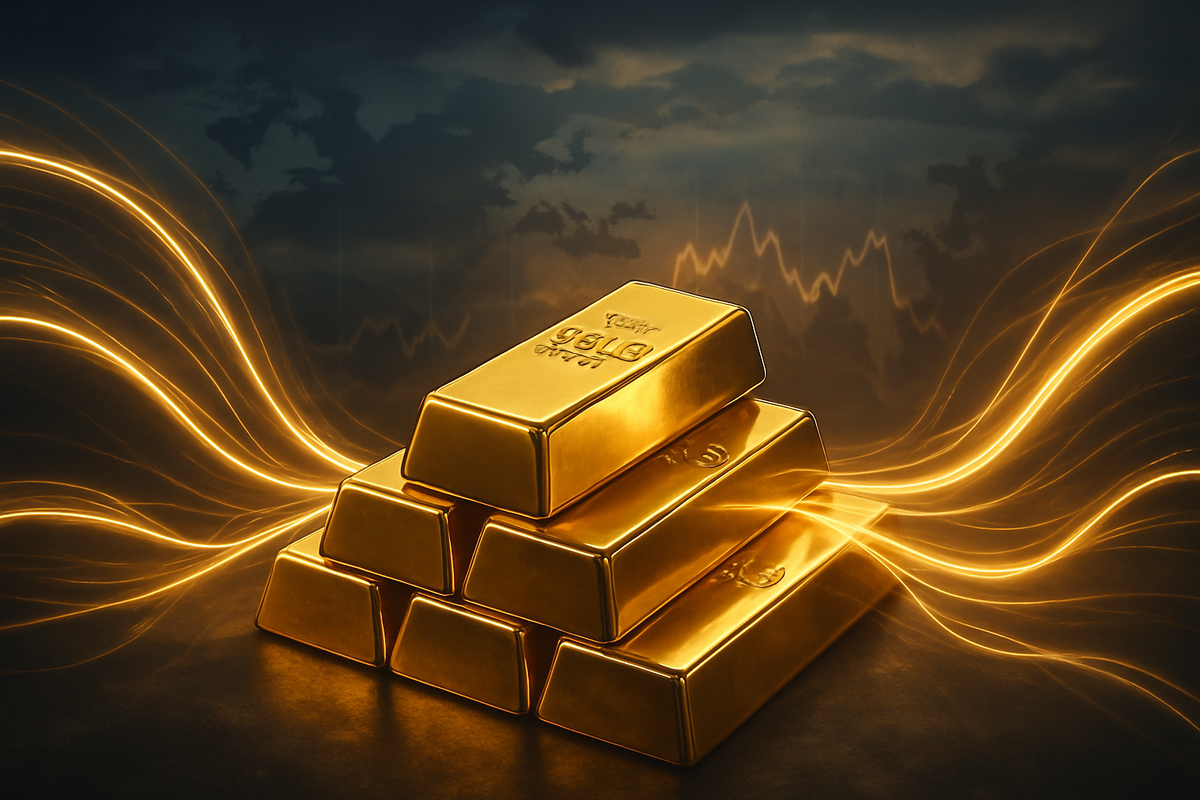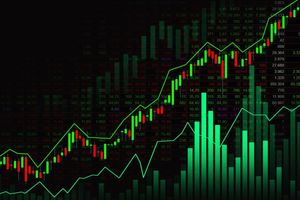
Gold has achieved an unprecedented milestone, surging to fresh all-time highs and nearing the formidable $4,000 per ounce mark as of October 2025. This historic ascent is largely propelled by a torrent of inflows into gold-backed Exchange Traded Funds (ETFs), signaling a profound shift in investor sentiment amidst a landscape of global uncertainty and economic recalibrations. The precious metal's robust performance underscores its enduring appeal as a safe-haven asset, drawing capital from institutions and individual investors alike who seek refuge from inflationary pressures and geopolitical instability.
The remarkable rally has significant implications for financial markets, potentially reshaping investment strategies and commodity outlooks. As gold continues its upward trajectory, it not only reflects a defensive posture among investors but also challenges traditional notions of portfolio diversification, highlighting a growing demand for tangible assets in an increasingly volatile world. This surge could herald a new era for gold, cementing its role as a critical component of global financial stability and a bellwether for underlying economic anxieties.
A Golden Ascent: Unpacking the $4,000 Milestone
The journey to nearly $4,000 an ounce has been nothing short of spectacular, building momentum throughout 2024 and accelerating dramatically into 2025. Gold prices began their significant upward trajectory in 2024, surpassing the $2,900/oz barrier in February and reaching $3,500/oz by April, influenced by unpredictable U.S. trade policies and a rise in global geopolitical risks. The precious metal concluded 2024 trading robustly around $2,623-$2,653 per ounce, setting the stage for its subsequent explosive growth.
The rally gained further intensity in 2025. March saw gold breach the psychological $3,000 per ounce mark for the first time, followed by a surge to $3,500 in April. By September 2025, gold had surpassed $3,800 an ounce, hitting a record $3,674 on September 10th and extending its winning streak for a seventh consecutive week. A 0.25% rate cut by the US Federal Reserve in mid-September further fueled the rally, pushing prices to approximately $3,703. By October 3, 2025, gold was trading between $3,894 and $3,901, and by October 6, 2025, it had reached $3,935.69 USD/t.oz, marking a 48.91% increase year-over-year and hitting an all-time high of $3949.07. This rapid 16% surge in just six weeks underscores the intense demand driving the market.
A pivotal factor in this historic surge has been the overwhelming inflow into gold-backed Exchange Traded Funds (ETFs). After a period of outflows from late 2020 to mid-2024, global gold ETF inflows turned positive in late 2024, totaling 63 tonnes from June to December. This trend intensified in 2025, with global physically-backed gold ETFs seeing net inflows of US$3 billion in January, primarily led by Europe. March 2025 witnessed gold ETF strategies reaching US$12.4 billion in inflows, the highest monthly total since 2020. By August 2025, the World Gold Council reported a record US$407 billion in gold-backed ETF assets, which further climbed to US$445 billion by the end of August year-to-date, marking the highest inflows since the 2020 peak. This sustained demand from ETFs represents a significant demand shock, compelling prices higher to balance the market.
Investor sentiment has been overwhelmingly bullish, driven by a "perfect storm" of macroeconomic and geopolitical factors. Gold's traditional role as a safe haven has been amplified by escalating geopolitical tensions, including ongoing conflicts in Ukraine and the Middle East, government fiscal challenges, and concerns about central bank independence. Expectations of multiple interest rate reductions by the Federal Reserve have also made non-yielding assets like gold more attractive. Furthermore, a weakening US dollar, stemming from a combination of tariffs and lower interest rates, has made gold cheaper for international buyers. Central banks globally have also been relentless buyers, purchasing over 1,000 tons of gold in 2024 for the third consecutive year, diversifying away from traditional currencies and reinforcing gold's appeal. Major financial institutions like HSBC, Goldman Sachs (NYSE: GS), Bank of America (NYSE: BAC), and JPMorgan Research (NYSE: JPM) have all revised their gold price targets upwards, with some projecting prices to exceed $4,000 per ounce in the near to medium term.
Corporate Fortunes in a Golden Era
The unprecedented surge in gold prices is poised to create clear winners and losers across various sectors, most notably within the mining industry and investment vehicles. Gold mining companies are undoubtedly at the forefront of beneficiaries, experiencing a significant boost to their revenues and profitability. Companies like Barrick Gold Corporation (NYSE: GOLD), Newmont Corporation (NYSE: NEM), and Agnico Eagle Mines Limited (NYSE: AEM) are seeing the value of their reserves appreciate considerably, leading to higher margins on extracted gold. Increased cash flows could enable these companies to expand exploration efforts, invest in new projects, or return capital to shareholders through dividends and buybacks. However, they also face potential challenges such as rising operational costs, including labor and energy, which could partially offset the gains from higher gold prices.
Conversely, some sectors might face indirect pressure. Industries that rely heavily on gold as a raw material, such as jewelry manufacturers or certain electronics companies, could see their input costs rise significantly. While some of these costs might be passed on to consumers, it could also impact demand or squeeze profit margins, particularly for companies operating in competitive markets. For instance, luxury goods retailers that feature gold jewelry might experience a slowdown in sales if consumers become price-sensitive to the elevated cost of gold.
Furthermore, the strong performance of gold could draw investment capital away from other asset classes, potentially affecting companies in sectors perceived as less stable or offering lower returns in the current economic climate. While not a direct loss, it represents a reallocation of capital that could temper growth in other areas. Companies operating in industries typically seen as growth-oriented but currently facing headwinds, such as certain technology or discretionary consumer sectors, might find it harder to attract investment if gold continues to offer compelling safe-haven returns.
The strong inflows into gold-backed ETFs benefit the providers of these funds, such as SPDR Gold Shares (NYSEARCA: GLD) and iShares Gold Trust (NYSEARCA: IAU), through increased assets under management and corresponding management fees. These financial products become more attractive to investors seeking direct exposure to gold's price movements without the complexities of physical storage. This trend also reinforces the role of financial institutions offering gold-related investment products, from derivatives to specialized funds, positioning them as key facilitators in the gold market's expansion.
Wider Implications of Gold's Historic Rally
Gold's dramatic ascent to near $4,000 an ounce fits squarely into broader industry trends characterized by increasing economic nationalism, persistent inflationary pressures, and a global shift away from reliance on a single reserve currency. This event is not merely a commodity price surge but a profound indicator of deep-seated anxieties within the global financial system. The sustained demand for gold, particularly from central banks and institutional investors, highlights a concerted effort to diversify reserves and hedge against the perceived instability of fiat currencies, especially the US dollar. This trend underscores a move towards a more multipolar financial world where tangible assets play a more significant role in national and institutional portfolios.
The ripple effects of this gold rally are likely to be extensive. Competitors in the safe-haven asset space, such as government bonds, may find themselves less attractive if their real yields remain negative or low compared to gold's performance. This could lead to a reallocation of capital, potentially increasing borrowing costs for governments. Partners in the supply chain, from mining equipment manufacturers to logistics providers, could see increased business activity driven by expanded exploration and production efforts from gold miners. However, the higher price of gold could also incentivize illegal mining activities, posing regulatory challenges and environmental concerns in various jurisdictions.
Regulatory and policy implications are also significant. Governments may consider new taxation policies on gold mining or sales to capture some of the increased value. Additionally, the role of gold in international trade and finance might come under renewed scrutiny, potentially leading to discussions about its inclusion in international monetary frameworks or its use as collateral in cross-border transactions. Historical precedents, such as the gold booms of the 1970s or the early 2000s, offer valuable comparisons. These periods were also marked by geopolitical instability, high inflation, and a weakening dollar. However, the current surge is distinguished by the unprecedented scale of central bank buying and the sophisticated financial instruments (like ETFs) that allow for broad investor participation, suggesting a more systemic and enduring shift rather than a cyclical fluctuation.
The sustained upward pressure on gold could also influence inflation expectations. As a traditional inflation hedge, gold's rising price can signal to markets that inflation may persist or even accelerate, prompting central banks to potentially reconsider their monetary policies. This could lead to a more hawkish stance from central banks, even amidst ongoing rate cuts, if they perceive gold's rally as a leading indicator of entrenched inflation rather than solely a safe-haven play. The interplay between gold prices, inflation, and monetary policy will be a critical area of focus for policymakers and economists alike.
The Road Ahead: Navigating a Golden Future
The future trajectory of gold, having breached historic highs, presents a landscape of both significant opportunities and formidable challenges for investors and market participants. In the short term, the momentum driven by robust ETF inflows and persistent geopolitical uncertainties suggests that gold prices could consolidate around current levels or even push further towards the $4,000 mark and beyond. Continued central bank buying and any further weakening of the US dollar would provide additional tailwinds. Investors might see further appreciation in gold mining stocks and gold-backed ETFs as the market digests the new price paradigm. However, potential short-term risks include profit-taking after such a rapid ascent, or any unexpected de-escalation of geopolitical tensions that could temporarily dampen safe-haven demand.
In the long term, the implications are more profound. Gold's sustained strength could necessitate strategic pivots for diversified portfolios, with a greater allocation to precious metals becoming a standard defensive strategy. For central banks, the trend of diversification away from the US dollar is likely to continue, potentially accelerating the move towards a multi-reserve currency system. This shift could lead to new dynamics in global trade and finance, where gold plays a more prominent role in international settlements and as a strategic asset. Market opportunities may emerge in the development of new financial products tied to gold, or in the expansion of mining operations in regions with untapped reserves. Challenges include managing the volatility inherent in commodity markets and adapting to potential regulatory changes aimed at stabilizing or taxing the gold market.
Potential scenarios and outcomes vary. A sustained period of high inflation coupled with geopolitical instability could see gold firmly establish itself above $4,000, potentially targeting $5,000 or higher in the coming years, particularly if global economic growth remains subdued. Conversely, a significant improvement in global stability, a strong recovery in major economies, or a hawkish shift from central banks leading to higher real interest rates could temper gold's ascent, leading to a period of consolidation or even a modest correction. However, given the current confluence of factors, a complete reversal of the bullish trend appears unlikely in the near to medium term. The underlying structural demand from central banks and the enduring appeal of gold as a store of value in uncertain times are powerful forces that will continue to support its price.
Ultimately, the market will be closely watching for shifts in monetary policy, particularly from the US Federal Reserve, and any significant developments in global geopolitical hotspots. The behavior of key institutional investors and the continued flow of capital into gold-backed ETFs will also serve as crucial indicators. The current environment suggests that gold is not just experiencing a temporary boom but rather a fundamental revaluation in response to evolving global financial and political landscapes.
A Golden Epoch: Assessing the Lasting Impact
The surge of gold prices to near $4,000 per ounce marks a pivotal moment in financial history, underscoring a significant recalibration of value in the face of profound global shifts. The key takeaway from this event is the undeniable resurgence of gold as a premier safe-haven asset, driven by a powerful combination of geopolitical instability, inflationary pressures, and a sustained appetite from both institutional and retail investors, channeled significantly through robust ETF inflows. This rally is not merely a cyclical phenomenon but indicative of a deeper, structural shift in investor preferences towards tangible assets that offer protection against systemic risks and currency debasement.
Moving forward, the market is likely to continue grappling with the implications of this new gold paradigm. The sustained demand from central banks, coupled with the accessibility provided by gold-backed ETFs, suggests that gold's elevated price levels may be more enduring than previous rallies. Investors should anticipate continued volatility but with a strong underlying support for gold prices. The precious metal is poised to remain a critical component in diversified portfolios, particularly for those seeking to hedge against macroeconomic uncertainties and currency fluctuations.
The lasting impact of this golden epoch will likely be seen in a re-evaluation of asset allocation strategies across the board. The traditional 60/40 stock-bond portfolio might see adjustments, with increased allocations to commodities, especially gold, becoming more prevalent. This event also highlights the growing influence of passive investment vehicles like ETFs in driving commodity markets, demonstrating their capacity to channel significant capital flows and influence price discovery. Policymakers will also need to consider the implications of a strong gold price on inflation expectations and the stability of national currencies.
Investors should closely monitor several key indicators in the coming months: the trajectory of global inflation, the monetary policy decisions of major central banks (especially the Federal Reserve), the evolution of geopolitical tensions, and the continued flow of funds into gold ETFs. Any significant shifts in these areas could either reinforce gold's upward trend or introduce new headwinds. The current environment, however, strongly suggests that gold has entered a new era of prominence, and its role as a bedrock of financial security is more pronounced than ever.
This content is intended for informational purposes only and is not financial advice






